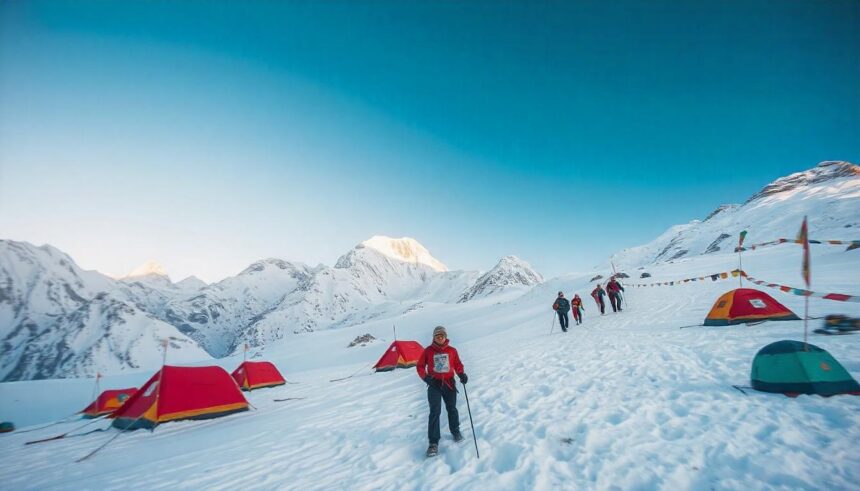Introduction to Mount Everest
Mount Everest, the towering giant of the Himalayas, stands as a beacon for adventurers and climbers from around the globe. At 29,032 feet above sea level, it embodies both beauty and peril. But how long does it take to climb Mount Everest? That’s a question that intrigues many aspiring mountaineers. The journey is not just about reaching the summit; it’s an expedition filled with challenges, preparation, and personal growth.
Climbing this majestic peak isn’t simply a matter of lacing up your boots and heading out. It requires meticulous planning, physical endurance, and mental fortitude. Each year, thousands attempt to conquer its heights while facing unpredictable weather conditions and treacherous terrain. Understanding what goes into an Everest expedition can provide valuable insights not only for climbers but also for those who admire this colossal mountain from afar.
So strap in as we explore everything you need to know about climbing Mount Everest—from preparation tips to tales from seasoned climbers—unraveling the mystery behind how long it truly takes to reach its legendary summit.
Factors Affecting the Time to Climb Everest
The time it takes to climb Mount Everest varies greatly, influenced by several key factors. Weather conditions play a significant role. Unpredictable storms can delay ascents and force climbers to wait for safer windows.
Altitude sickness is another crucial factor. As climbers ascend, their bodies must acclimatize to decreasing oxygen levels. This process requires additional rest days.
Route choice also impacts timing. The South Col route is more popular but can be crowded during peak seasons, leading to longer waits for summit bids.
Physical fitness cannot be overlooked either. Those with stronger endurance may progress faster than less fit climbers.
The experience level of each team member matters significantly—experienced guides navigate challenges quicker and more efficiently compared to novice teams navigating for the first time on such terrain.
Preparing for the Climb: Physical and Mental Training
Preparing for the ascent of Mount Everest requires more than just physical strength. It’s a mental game as well. You’ll need resilience and determination to face challenges along the way.
Physical training should start months in advance. Focus on building endurance through long hikes, running, and cycling. Incorporate strength training to boost your climbing-specific muscles.
Don’t neglect altitude acclimatization either. Spend time in high-altitude environments if possible. This will help your body adjust before reaching those dizzying heights.
Mental preparation is equally crucial. Visualize each step of the climb, from base camp to summit day. Developing coping strategies for stress can also make a significant difference when facing extreme conditions.
Join mountaineering groups or seek guidance from experienced climbers to hone both skills and mindset further. The goal is not only to reach the top but also to enjoy every moment during this epic journey.
The Different Routes and Their Difficulty Levels
Climbing Mount Everest offers several routes, each with distinct challenges. The two most popular are the South Col route from Nepal and the North Ridge route from Tibet.
The South Col is renowned for its accessibility and established infrastructure. This path features well-marked trails but demands resilience against altitude sickness due to rapid elevation gain.
On the other hand, the North Ridge presents a more technical climb. This route involves navigating ice walls and steep rock faces, making it less forgiving for inexperienced climbers.
Weather plays a crucial role in both routes. Sudden storms can turn treacherous fast, testing even seasoned mountaineers.
Every climber must assess their skills honestly before choosing a path. Understanding the difficulty level of each route helps prepare mentally and physically for what lies ahead on this monumental journey to the summit of Everest.
Typical Duration of a Mount Everest Expedition
Climbing Mount Everest is no casual endeavor. The typical duration of an expedition ranges from two to three months, depending on various factors.
During this time, climbers acclimatize to the high altitude. This process is crucial for minimizing the risk of altitude sickness. Most teams spend about six weeks gradually ascending and descending between camps.
Base Camp serves as a home base where climbers prepare their gear and strategies. From there, they make multiple trips up the mountain before attempting a final summit push.
The weather plays a significant role in determining when teams can safely attempt to reach the top. Unpredictable storms or winds can force delays.
Patience becomes just as important as physical endurance during this long journey into thin air.
Personal Stories from Experienced Climbers
Climbers often share unforgettable tales from their journeys on Mount Everest. Each story is a testament to human resilience and the spirit of adventure.
One climber recalls the moment they reached Camp IV, feeling an overwhelming mix of excitement and fear. The air was thin, but the view was breathtaking. They could see the summit shimmering in the distance—a goal that felt both close and impossibly far.
Another adventurer speaks of facing fierce storms at high altitudes. Battling freezing temperatures while trying to maintain morale within their team created bonds forged through adversity.
There are also stories of unexpected camaraderie among competitors. Strangers helped each other with essentials like oxygen tanks and gear adjustments, proving that kindness thrives even in extreme conditions.
These experiences underscore not just personal triumphs but connections made amidst harsh realities. Every ascent brings unique memories etched into the hearts of those who dare to climb Everest’s formidable heights.
Challenges and Dangers of Climbing Mount Everest
Climbing Mount Everest is an awe-inspiring feat, but it comes with significant challenges and dangers. The altitude poses a major risk; at 29,032 feet, the thin air can lead to altitude sickness. Symptoms like headaches and nausea can strike unexpectedly.
Weather conditions are unpredictable. Sudden storms can sweep across the mountain, bringing fierce winds and whiteouts that disorient climbers. This unpredictability makes timing crucial during any expedition.
Another concern is avalanches and crevasses hidden beneath snow. These natural hazards require constant vigilance as they can change rapidly.
The physical demands on the body also can’t be ignored. Climbing for days in extreme conditions tests both strength and endurance.
There’s always the psychological toll of isolation at such heights. Loneliness combined with exhaustion creates mental hurdles that must be overcome to reach the summit safely.
Tips for a Successful Summit Attempt
When preparing for a summit attempt, focus on acclimatization. Spend ample time at base camp to allow your body to adjust to the altitude. Rushing this process increases risk.
Prioritize proper gear selection. A good pair of boots can make or break your experience. Ensure they fit well and are broken in before the climb.
Nutrition plays a crucial role too. Eat high-energy foods that keep you fueled throughout the journey. Hydration is equally essential; drink plenty of water to combat dehydration.
Mental preparation is often overlooked but vital. Visualize success and develop strategies for dealing with unexpected challenges during the ascent.
Trust your team and communicate openly about concerns or fatigue levels. Climbing Everest isn’t just an individual challenge; it’s a collective effort where support makes all the difference.
Conclusion: Determination and Preparation are Key in Conquering Mount Everest
Climbing Mount Everest is not just about reaching the summit. It requires immense determination and extensive preparation. The journey involves physical conditioning, mental resilience, and strategic planning.
Every climber faces unique challenges. Weather conditions can change dramatically in a matter of hours. Altitude sickness poses a significant threat to those who are unprepared. A successful ascent demands thorough training and careful acclimatization.
Choosing the right route also plays a crucial role in your expedition timeline. Each path offers different difficulties, influencing how long you’ll be on the mountain. Experienced climbers emphasize that understanding these factors is essential for timing your climb effectively.
Every aspiring summiteer should remember that it’s not merely about how long does it take to climb Mount Everest; it’s about embracing the adventure with passion and respect for nature’s grandeur. With grit and proper preparation, reaching the roof of the world becomes an achievable dream rather than an insurmountable challenge.







